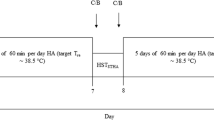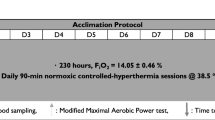Abstract
Purpose
Recent studies have determined that ambient humidity plays a more important role in aerobic performance than dry-bulb temperature does in warm environments; however, no studies have kept humidity constant and independently manipulated temperature. Therefore, the purpose of this study was to determine the contribution of dry-bulb temperature, when vapor pressure was matched, on the thermoregulatory, perceptual and performance responses to a 30-min cycling work trial.
Methods
Fourteen trained male cyclists (age: 32 ± 12 year; height: 178 ± 6 cm; mass: 76 ± 9 kg; \(\dot{V}{\text{O}}_{{{2}\,{\max}}}\): 59 ± 9 mL kg−1 min−1; body surface area: 1.93 ± 0.12 m2; peak power output: 393 ± 53 W) volunteered, and underwent 1 exercise bout in moderate heat (MOD: 34.9 ± 0.2 °C, 50.1 ± 1.1% relative humidity) and 1 in mild heat (MILD: 29.2 ± 0.2 °C, 69.4 ± 0.9% relative humidity) matched for vapor pressure (2.8 ± 0.1 kPa), with trials counterbalanced.
Results
Despite a higher weighted mean skin temperature during MOD (36.3 ± 0.5 vs. 34.5 ± 0.6 °C, p < 0.01), none of rectal temperature (38.0 ± 0.3 vs. 37.9 ± 0.4 °C, p = 0.30), local sweat rate (1.0 ± 0.3 vs. 0.9 ± 0.4 mg cm−2 min−1, p = 0.28), cutaneous blood flow (283 ± 116 vs. 287 ± 105 PU, p = 0.90), mean power output (206 ± 37 vs. 205 ± 41 W, p = 0.87) or total work completed (371 ± 64 vs. 369 ± 70 kJ, p = 0.77) showed any difference between environments during the work trial. However, all perceptual measures (perceived exertion, thermal discomfort, thermal sensation, skin wettedness, pleasantness, all p < 0.05) were affected detrimentally during MOD compared to MILD.
Conclusion
In a warm and compensable environment, dry-bulb temperature did not influence high-intensity cycling performance when vapor pressure was maintained, whilst the perceptual responses were affected.





Similar content being viewed by others
Abbreviations
- BSA:
-
Body surface area
- CVR:
-
Cutaneous vascular resistance
- η p 2 :
-
Partial eta-squared
- E max :
-
Maximal evaporative capacity of the environment
- E req :
-
Required evaporative cooling for heat balance
- HR:
-
Heart rate
- HSI:
-
Heat strain index
- LSR:
-
Local sweat rate
- MAP:
-
Mean arterial pressure
- PETCO2 :
-
Partial pressure of end-tidal CO2
- \(\dot{Q}\) :
-
Cardiac output
- \(\dot{Q}_{{{\text{sk}}}}\) :
-
Skin blood flow
- RER:
-
Respiratory exchange ratio
- RPE:
-
Rating of perceived exertion
- SV:
-
Stroke volume
- T core :
-
Core body temperature
- T rec :
-
Rectal temperature
- \(\bar{T}_{{{\text{sk}}}}\) :
-
Mean skin temperature
- \(\dot{V}{\text{O}}_{2}\) :
-
Rate of oxygen uptake
- \(\dot{V}{\text{O}}_{{{2}\,{\max}}}\) :
-
Maximal rate of oxygen uptake
- WBSR:
-
Whole-body sweat rate
References
Attia M (1984) Thermal pleasantness and temperature regulation in man. Neurosci Biobehav Rev 8(3):335–342
Attia M, Engel P (1981) Thermal alliesthesial response in man is independent of skin location stimulated. Physiol Behav 27(3):439–444
Belding HS, Hatch TF (1955) Index for evaluating heat stress in terms of resulting physiological strain. Heat Piping Air Cond 27:129–136
Borg G (1970) Perceived exertion as an indicator of somatic stress. Scand J Rehabil Med 2(2):92–98
Che Muhamed AM, Atkins K, Stannard SR, Mündel T, Thompson MW (2016) The effects of a systematic increase in relative humidity on thermoregulatory and circulatory responses during prolonged running exercise in the heat. Temperature 3(3):455–464
Cheung SS, McLellan TM, Tenaglia S (2000) The thermophysiology of uncompensable heat stress: physiological manipulations and individual characteristics. Sports Med 29:329–359
Cheuvront SN, Kenefick RW, Montain SJ, Sawka MN (2010) Mechanisms of aerobic performance impairment with heat stress and dehydration. J Appl Physiol 109(6):1989–1995
Chou TH, Allen JR, Hahn D, Leary BK, Coyle EF (2018) Cardiovascular responses to exercise when increasing skin temperature with narrowing of the core-to-skin temperature gradient. J Appl Physiol 125(3):697–705
Cohen J (1988) Statistical power analysis for the behavioral sciences. Lawrence Earlbaum Associates, Hillsdale
De Pauw K, Roelands B, Cheung SS, de Geus B, Rietjens G, Meeusen R (2013) Guidelines to classify subject groups in sport-science research. Int J Sports Physiol Perform 8:111–122
Defares JG (1958) Determination of pvco2 from the exponential CO2 rise during rebreathing. J Appl Physiol 3:159–164
Dubois D, Dubois EF (1916) A formula to estimate approximate surface area if height and weight be known. Arch Intern Med 17:863–871
Ely BR, Cheuvront SN, Kenefick RW, Sawka MN (2010) Aerobic performance is degraded, despite modest hyperthermia, in hot environments. Med Sci Sports Exerc 42(1):135–141
Flouris AD, Schlader ZJ (2015) Human behavioral thermoregulation during exercise in the heat. Scand J Med Sci Sports 25(Suppl 1):52–64
Gagge AP, Stolwijk J, Saltin B (1969) Comfort and thermal sensations and associated physiological responses during exercise at various ambient temperatures. Environ Res 2(3):209–229
Gagnon D, Jay O, Kenny GP (2013) The evaporative requirement for heat balance determines whole-body sweat rate during exercise under conditions permitting full evaporation. J Physiol 591:2925–2935
Galloway SD, Maughan RJ (1997) Effects of ambient temperature on the capacity to perform prolonged cycle exercise in man. Med Sci Sports Exerc 29:1240–1249
González-Alonso J, Crandall CG, Johnson JM (2008) The cardiovascular challenge of exercising in the heat. J Physiol 586(1):45–53
Graichen H, Rascati R, Gonzalez R (1982) Automatic dew-point temperature sensor. J Appl Physiol 52(6):1658–1660
Hensel H (1981) Thermoreception and temperature regulation. Academic Press, London
Jeukendrup A, Saris WH, Brouns F, Kester AD (1996) A new validated endurance performance test. Med Sci Sports Exerc 28(2):266–270
Jones NL, Robertson DG, Kane JW (1979) Difference between end-tidal and arterial PCO2 in exercise. J Appl Physiol 47:954–960
Kenney WL (1998) Heat flux and storage in hot environments. Int J Sports Med 19(Suppl 2):S92–95
Kerslake DM (1972) The stress of hot environments. Cambridge University Press, London
Kondo N, Takano S, Aoki K, Shibasaki M, Tominaga H, Inoue Y (1998) Regional differences in the effect of exercise intensity on thermoregulatory sweating and cutaneous vasodilation. Acta Physiol Scand 164(1):71–78
Lei TH, Stannard SR, Perry BG, Schlader ZJ, Cotter JD, Mündel T (2017) Influence of menstrual phase and arid vs. humid heat stress on autonomic and behavioural thermoregulation during exercise in trained but unacclimated women. J Physiol 595(9):2823–2837
Lei TH, Cotter JD, Schlader ZJ et al (2019) On exercise thermoregulation in females: interaction of endogenous and exogenous ovarian hormones. J Physiol 597(1):71–88
Marino FE, Mbambo Z, Kortekaas E et al (2000) Advantages of smaller body mass during distance running in warm, humid environments. Pflugers Arch 441:359–367
Maughan RJ, Otani H, Watson P (2012) Influence of relative humidity on prolonged exercise capacity in a warm environment. Eur J Appl Physiol 112(6):2313–2321
McHardy GJR (1967) Relationship between differences in pressure and content of carbon dioxide in arterial and venous blood. Clin Sci 32(2):299–309
Mündel T, Carter JM, Wilkinson DM, Jones DA (2016) A comparison of rectal, oesophageal and gastro-intestinal tract temperatures during moderate-intensity cycling in temperate and hot conditions. Clin Physiol Funct Imaging 36(1):11–16
Mündel T, Houltham SD, Barnes MJ, Stannard SR (2019) Nicotine supplementation does not influence performance of a 1h cycling time-trial in trained males. Front Physiol 10:292
Nybo L, Rasmussen P, Sawka MN (2014) Performance in the heat-physiological factors of importance for hyperthermia-induced fatigue. Compr Physiol 4(2):657–689
Parkin JM, Carey MF, Zhao S, Febbraio MA (1999) Effect of ambient temperature on human skeletal muscle metabolism during fatiguing submaximal exercise. J Appl Physiol 86:902–908
Paterson DH, Cunningham DA (1976) Comparison of methods to calculate cardiac output using the CO2 rebreathing method. Eur J Appl Physiol Occup Physiol 35:223–230
Périard JD, Cramer MN, Chapman PG, Caillaud C, Thompson MW (2011) Cardiovascular strain impairs prolonged self-paced exercise in the heat. Exp Physiol 96(2):134–144
Racinais S, Alonso JM, Coutts AJ et al (2015) Consensus recommendations on training and competing in the heat. Scand J Med Sci Sports 25(Suppl 1):6–19
Ramanathan N (1964) A new weighting system for mean surface temperature of the human body. J Appl Physiol 19(3):531–533
Saunders AG, Dugas JP, Tucker R, Lambert MI, Noakes TD (2005) The effects of different air velocities on heat storage and body temperature in humans cycling in a hot, humid environment. Acta Physiol Scand 183(3):241–255
Sawka MN, Leon LR, Montain SJ, Sonna LA (2011) Integrated physiological mechanisms of exercise performance, adaptation, and maladaptation to heat Stress. Compr Physiol 1(4):1883–1928
Schlader ZJ, Mündel T, Barnes MJ, Hodges LD (2010a) Peak cardiac power output in healthy, trained men. Clin Physiol Funct Imaging 30:480–484
Schlader ZJ, Stannard SR, Mündel T (2010b) Human thermoregulatory behavior during rest and exercise—a prospective review. Physiol Behav 99(3):269–275
Schlader ZJ, Simmons SE, Stannard SR, Mündel T (2011a) Skin temperature as a thermal controller of exercise intensity. Eur J Appl Physiol 111(8):1631–1639
Schlader ZJ, Simmons SE, Stannard SR, Mündel T (2011b) The independent roles of temperature and thermal perception in the control of human thermoregulatory behavior. Physiol Behav 103(2):217–224
Schlader ZJ, Stannard SR, Mündel T (2011c) Evidence for thermoregulatory behavior during self-paced exercise in the heat. J Therm Biol 36(7):390–396
Schlader ZJ, Stannard SR, Mündel T (2011d) Is peak oxygen uptake a determinant of moderate-duration self-paced exercise performance in the heat? Appl Physiol Nutr Metab 36(6):863–872
Tatterson AJ, Hahn AG, Martini DT, Febbraio MA (2000) Effects of heat stress on physiological responses and exercise performance in elite cyclist. J Sci Med Sport 3:186–193
Tikuisis P, McLellan TM, Selkirk G (2002) Perceptual versus physiological heat strain during exercise-heat stress. Med Sci Sports Exerc 34(9):1454–1461
Tucker R, Rauch L, Harley YX, Noakes TD (2004) Impaired exercise performance in the heat is associated with an anticipatory reduction in skeletal muscle recruitment. Pflugers Arch 448(4):422–430
Acknowledgements
No external funding supported this study.
Author information
Authors and Affiliations
Contributions
THL, ZJS, JDC and TM contributed to conceptualization and design. THL, AMCM, HZ, SRS and TM were responsible for data collection. THL, ZJS and TM were responsible for data analysis, interpretation and drafting of the article. AMCM, HZ, SRS, NK and JDC reviewed the article and provided critical feedback. All authors approved the final manuscript. There are no conflicts of interest to report.
Corresponding author
Ethics declarations
Conflict of interest
There are no conflicts of interest to report.
Additional information
Communicated by George Havenith.
Publisher's Note
Springer Nature remains neutral with regard to jurisdictional claims in published maps and institutional affiliations.
Rights and permissions
About this article
Cite this article
Lei, TH., Schlader, Z.J., Che Muhamed, A.M. et al. Differences in dry-bulb temperature do not influence moderate-duration exercise performance in warm environments when vapor pressure is equivalent . Eur J Appl Physiol 120, 841–852 (2020). https://doi.org/10.1007/s00421-020-04322-8
Received:
Accepted:
Published:
Issue Date:
DOI: https://doi.org/10.1007/s00421-020-04322-8




